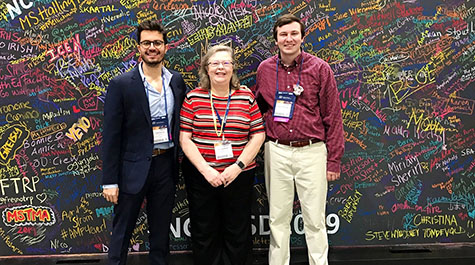Making Mathematics Relevant: Using Culture to Teach Math
School of Education alumni Paul Naanou ’17, M.A.Ed. ’18 and Jay Sandridge ’17, M.A.Ed. ’18 were inspired by the first conference they attended of the National Council of Teachers of Mathematics (NCTM). Both secondary math education students at W&M, they were able to attend the organization’s annual conference in Washington, D.C. in Spring 2018. Not only did they gain guidance in teaching and educational resources but by the end of the conference, they were also determined to return the next year as first-year teachers, contributing with a presentation of their own.
Having learned about inquiry-based problem solving and culturally-relevant pedagogy at W&M and at last year's conference, both alumni felt that they could help teachers bridge the gap between learning math in the classroom and using it to solve real problems in the world.
Fast-forward a year later, and the two alumni traveled to San Diego to present at NCTM 2019. Using real-world cultural examples to problem-solve in a variety of high school math classes including geometry, algebra, calculus and statistics, they demonstrated to teachers how incorporating culture can encourage students to ask questions, thus engaging them in the subject and developing their critical thinking skills. Including global and cultural perspectives in the math classroom is important to Sandridge, because “the contexts we choose send powerful messages to our students. The world is growing closer, and it's critical for students to learn about and understand other cultures.”
Margie Mason, professor of math education, encouraged the two alumni to submit a proposal to present at the conference. “It is very unusual for a first-year teacher to be accepted as a presenter at this conference—or even have the guts to apply,” she said. “It is truly a remarkable achievement.”
The two teachers, who are now entering their second year of teaching in northern Virginia high schools, became friends through the tight-knit math education cohort at William & Mary, where they worked together as graduate assistants. They were also Noyce Scholars, a program that supports science and mathematics majors and professionals planning to become STEM educators teaching in high-need school districts.
While attending the conference as students, they took a variety of sessions on educational theory and practice to prepare them for their first year in the classroom. Returning as first-year teachers, they focused on attending sessions that directly applied to their classroom, but also wanted to contribute their idea of using real problems in the world to engage students and make them interested in problem-solving mathematics.
The idea to connect real-world problems to mathematics concepts students were learning in the classroom came from a journal article Naanou worked on at the School of Education with an adjunct professor about finding the volume of qatayef, a Levantine dessert.
Naanou knew that there was an opportunity and need to expand the connection and motivate students to learn. “We live in a world where problem-solving requires an interdisciplinary approach,” he said. “Skills such as communication and making sense of the unfamiliar are key to succeeding in a world centered around globalization and so our math classrooms need to create microcosms in which students can safely navigate through the learning of these skills.”
